Beer and bread were the staples in the diet of the ancient Egyptians. But what else did they eat? What about meat such as beef and pork? Was it reserved for the consumption of the rich, as was the case in many ancient cultures? Did they raise cattle? Did they farm? Were fruits and vegetables a regular part of the ancient Egyptian diet?
Table of Contents
Ancient Egyptian Food: What Did the Ancient Egyptians Eat?
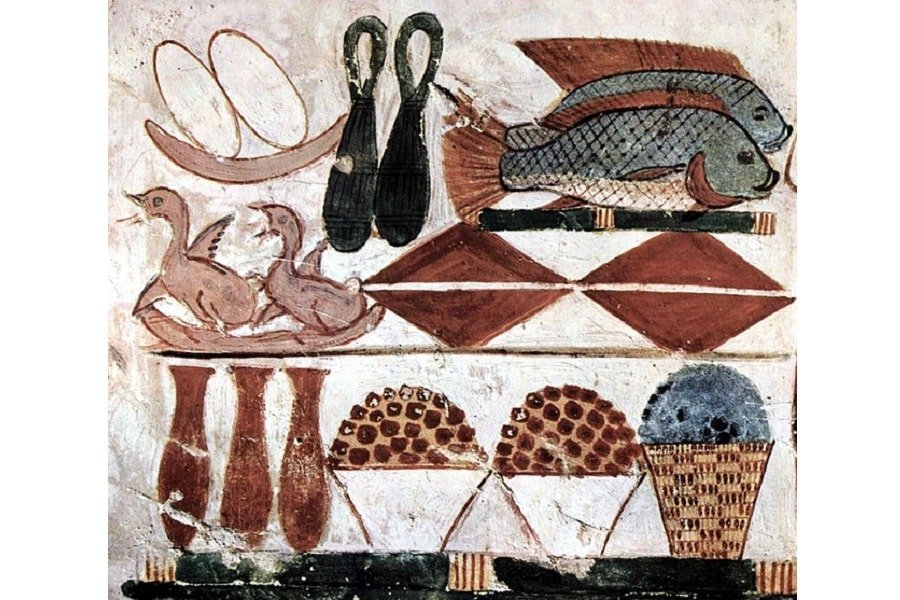
The people of ancient Egypt lived in a rather fertile valley, so we can safely assume that they grew a lot of their own food. They also must have reared animals and the Nile river itself would have provided them with a great part of their needs.
Surprisingly enough, for a civilization that spanned over 3000 years, the people of ancient Egypt seemed to keep a rather consistent diet. For the most part, both rich and poor ate bread and beer, accompanied by vegetables like green onions as well as some meat, poultry, and fish.
Bread and Beer as Staple Foods in Ancient Egypt
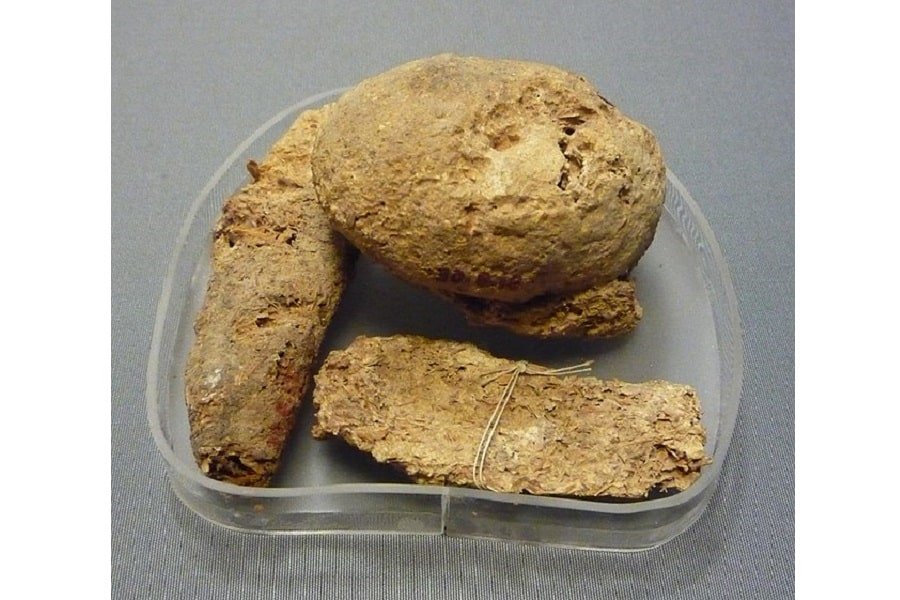
Bread and beer were the staples of ancient Egyptian food. Just like the ancient Greeks liked their wine, the ancient Egyptians were very fond of their beer and drank it whenever they could. Ancient Egyptian beer was even used as currency because it was such an important part of their lives!
The people of ancient Egypt are well known for their love of beer. Men, women, and children all drank beer on a regular basis and it was considered a primary source of nutrition. While ancient Egyptian children were introduced to beer at a young age, young scribes were apparently warned against the dangers of intoxication by their school teachers.
The ancient Egyptian beer was not like modern European beer but more like modern African beers, cloudy and nutritious with lots of solids. It was a bit like gruel in that aspect. It was a source of proteins, vitamins, and minerals. Beer jars were often used as a measurement of value and beer as medicine.
A very interesting ancient Egyptian painting in the Egyptian Museum in Berlin, Germany, shows people drinking beer with straws. This might be the first evidence of the use of straws by humans.
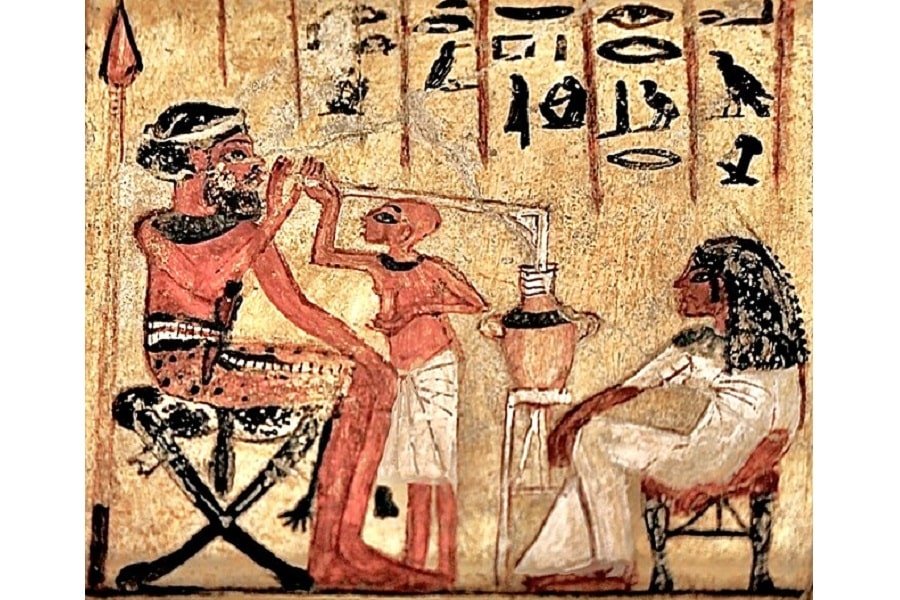
According to archaeologists, beer was first made by baking beer bread. This was a type of well-leavened bread that was baked lightly so as to not kill the yeast. It was then crumbled over a sieve, washed down with water in a vat, and left to ferment. Even now, Egyptian households brew a home beer that is quite similar.
Bread, the staple food of ancient Egypt, was made from emmer wheat. This type of wheat was more difficult to turn into flour than other kinds of wheat. In the Old Kingdom, bread was baked by filling heavy pottery molds with dough and baking them over the embers of a fire. In the New Kingdom, large, open, cylindrical clay ovens were used and the bread was slapped on the heated inner walls to bake.
Bread in the New Kingdom took on a variety of fancy shapes, like obelisks, geese, humans, cattle, gazelles, flowers, fruit, vases, and geometric shapes. We know that bread was the most important ancient Egyptian food item because tomb owners requested that visitors bring 1000 loaves of bread to the tombs of the people they loved.
Other than emmer, some other kinds of nuts and grains used to make bread were barley, tiger nut, and lily seeds and roots. The rich also used fine cakes and dessert bread made with the grain of the highest quality.
The people of ancient Egypt also drank wine but this was restricted to the rich and people in the uppermost strata of society. Old recipes for Egyptian wine have been found in Baghdad in the 10th century CE. These describe the same processes of making wine as art and archaeological remains of the time have depicted. The wine was made from grapes, plums, and pomegranates. The ancient Egyptian people also drank fruit juices and herbal infusions, along with water from the Nile.
Meat for the Rich
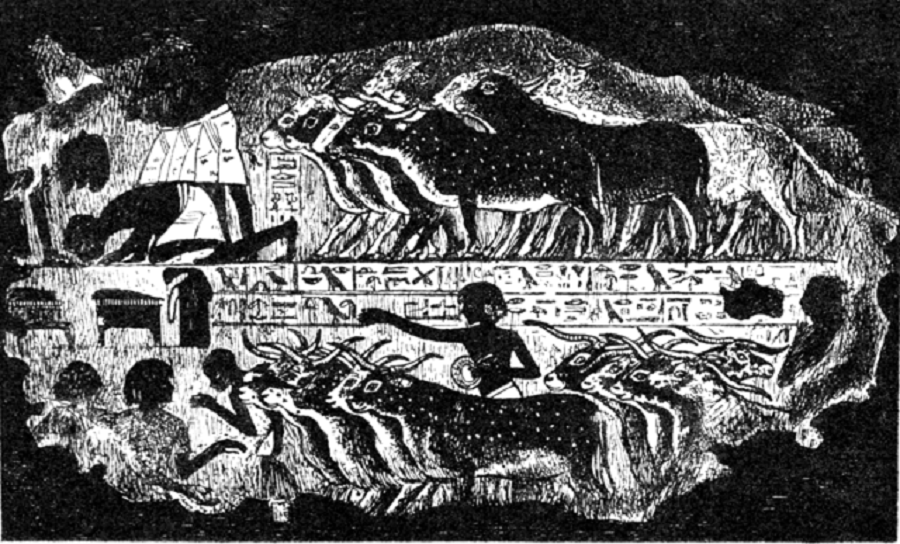
The people of ancient Egypt also raised cattle from the earliest days. High-quality beef was available for consumption. However, it is very likely that this was only for the rich. The common people might have enjoyed beef only on occasions such as festivals and holidays. In ancient times, the temples distributed the offerings of the Egyptian gods and goddesses to the poor on special days.
The different types of meat the Egyptians raised were cows, goats, pigs, and sheep. Pigs only came to be widely eaten after the Greco-Roman period in Egypt because the ancient Egyptian priests had previously linked pigs with the evil god Set. According to the Greek historian Herodotus, pork was considered unclean. The Egyptians also did not consume female cows because they were considered sacred to Isis. Male oxen were ritually slaughtered as sacrifices after they were declared healthy.
Archaeological excavations in the worker’s village in Giza have unearthed evidence of the massive slaughter of oxen. Thus, it seems the workers were fed beef regularly while they were building the Great Pyramid. Mutton was more commonly eaten than beef.
Poultry for the Common People
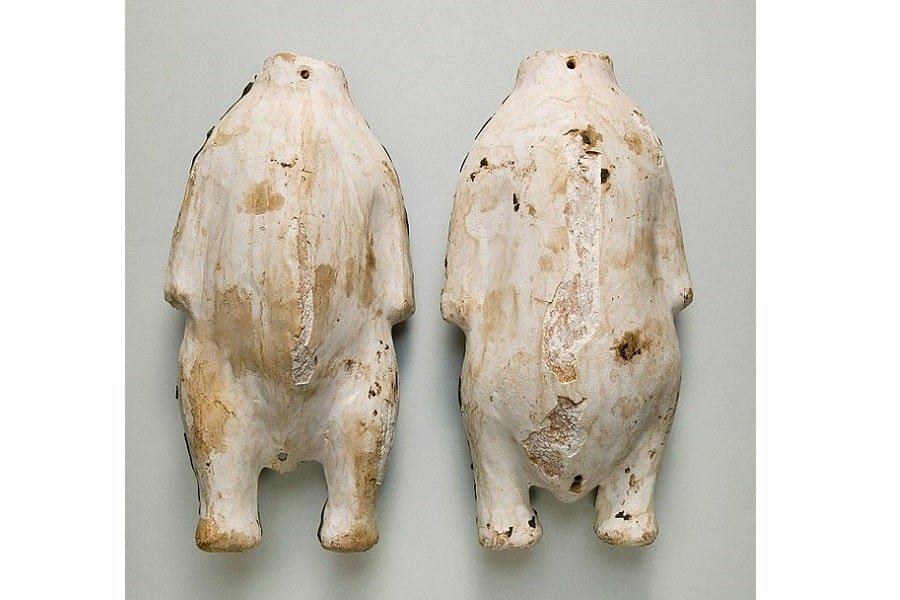
On the other hand, poultry, and game meat of various kinds were a common ancient Egyptian food. This included ducks, geese, pigeons, partridge, quails, cranes, flamingoes, European coots, pelicans, doves, and various other birds. Chickens did not arrive until the 5th or 4th century CE.
Living on the banks of the flourishing Nile River meant that the people of ancient Egypt had access to various kinds of birds that would come to the river. The Egyptians also raised fowl in domestication. We know this because the Egyptians very possibly invented foie gras, which is a method of deliberately fattening up ducks and geese before eating them.
All but the poorest people could eat poultry, both wild and domestic. The Egyptians possibly hunted birds that populated the riverbank. The Egyptians are also said to have eaten hedgehogs and mice, the former by baking them in a clay casing so the spikes could be removed easily.
Fish and Dairy
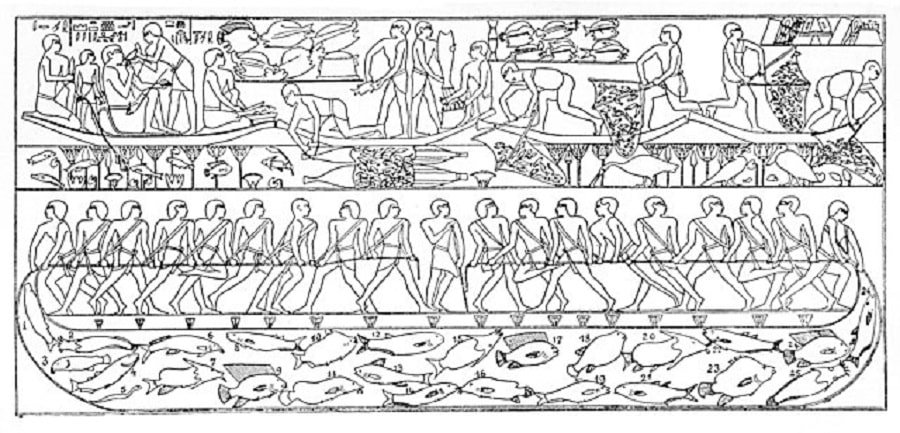
The ancient Egyptians, of course, ate fish. Because of the Nile and all its canals, it was the most commonly accessed protein source. All but the most destitute could eat fish. Fish could be eaten fresh, but just like the ancient Greeks, the people of ancient Egypt often ate air-dried and salted fish.
One common fish byproduct was a food item that is still eaten in many Mediterranean countries today. It is called ‘boutargue’ in French and ‘bottargo’ in Italian. Considered an aphrodisiac, this dish is salted and pressed fish ovaries.
Other sources of protein were legumes, milk, cheese, butter, and eggs. Cow milk and goat milk were enjoyed fresh while donkey milk was prescribed for medical reasons. Archaeological evidence of cheese has been found in ancient Egyptian tombs. They probably made cottage cheese similar to versions that are still found in modern Egypt.
While the people of ancient Egypt seem to have known of beans and legumes, it is not clear how exactly they prepared them. Pulses and legumes such as chickpeas, beans, peas, and lentils would have been important sources of protein for the poorer classes.
The common consensus is they made a sort of soup or stew with these. Seasoning such as salt, cumin, pepper, coriander, sesame, dill, and fennel was known by the Egyptians. Seasoned and spiced stews were a part of Egyptian food and the use of lentils in these stews is a basic deduction.
Vegetables and Fruits
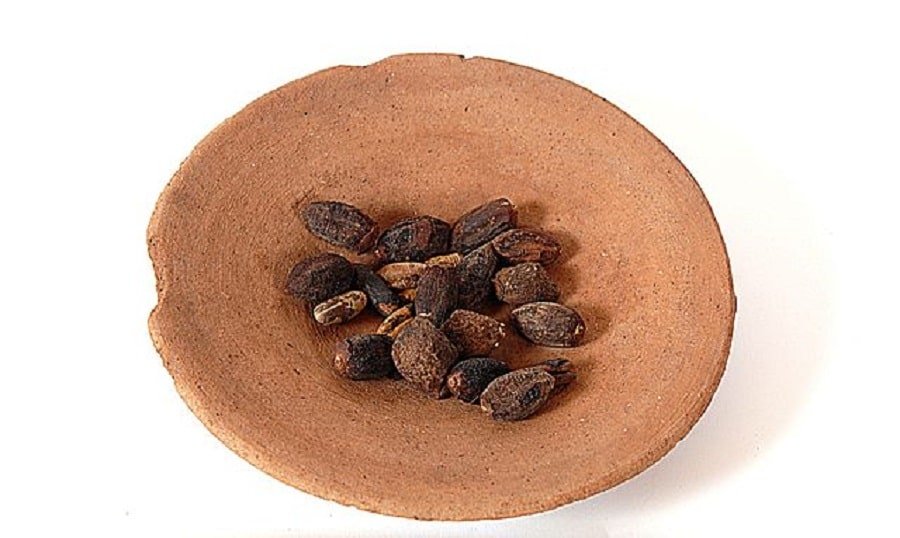
Vegetables and fruits seem to have been an important part of ancient Egyptian cuisine. Several vegetables and fruits were possibly simply eaten fresh by the ancient Egyptians. Indeed, modern Egyptian food includes a lot of raw vegetables and fruits so this is a tradition that could have carried down through the ages.
Green onions and garlic were the most common type of vegetables eaten, although both also had medicinal uses. Other kinds of vegetables and greens included celery, lettuce, cucumber, gourds, and melons. These could all be eaten raw or used in stews. Tubers like papyrus were eaten roasted, raw, boiled, or ground into flour. This flour was often used to make desserts when sweetened with honey. Sugar was not a part of ancient Egyptian food.
Flowering aquatic plants like the lily and the lotus flower were used for their shoots and roots. Jars for storing olive oil have been discovered in the Giza worker’s village as far back as the 4th dynasty. This implies that the Egyptians either could make olive oil or imported it from the Greeks for use.
Common fruits that were part of Egyptian food were grapes, dates, pomegranates, figs, palm nuts, and some kinds of berries. Many of these fruits would be eaten in both fresh and dried forms. They were served at the end of the meal alongside honey as a dessert. They were even used as sweeteners because of their high sugar content. In the Greco-Roman period, peaches and pears were also introduced in Egypt.
The Meals of the Day
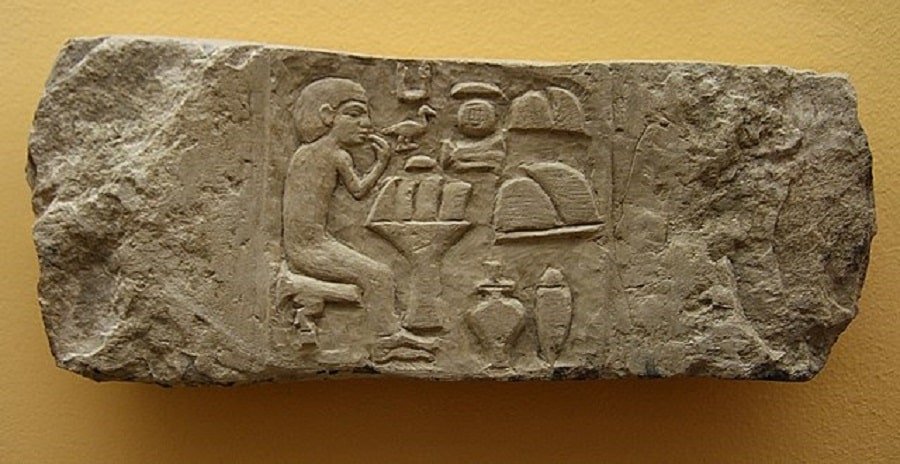
We do not have a clear idea of how many meals the ancient Egyptians ate. It is possible that the wealthier people ate two or three meals a day, based on ancient Egyptian art. They made a light breakfast of bread and beer, followed by a heavier midday meal, and dinner at the end of the day.
For poorer folks, the custom was probably two meals a day – a light morning meal which consisted of bread, and another meal in the afternoon, made up of bread, beer, some onions, and perhaps some grilled poultry.
There are various tomb pictures of a husband and wife seated side by side with an elaborate meal laid out in front of them. We cannot take this at face value because it was meant to be a depiction of the Egyptian afterlife. Thus, this was the ideal, and real life was not the ideal. Realistic art was much rarer. A peasant’s meal would probably be taken out in the fields or the marshes, with a very simple fare.
Cooks

Men and women both participated in food preparation in those days. Ancient art would tell us that men were more involved in cooking at the temples and they prepared their own food in the fields. Women, by contrast, did much of the cooking at home. Cooking was not a glamorous job in ancient Egypt. There was no great status attached to it. Technically, it was the responsibility of the man to provide the food while the women cooked it.
Fasts and Feasts
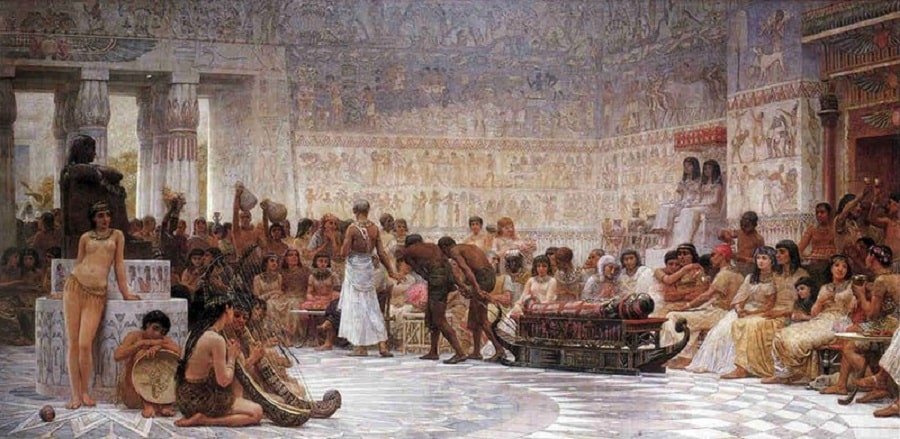
In ancient Egypt, both fasting and feasting had important ritual meanings. Fasting was meant to purify the body and soul. It was used to observe spiritual devotion. Feasts, on the other hand, were held during festivals and were meant to celebrate joyous occasions. The Metropolitan Museum of Art has various slabs and paintings that depict banquets and feasts.
Banquets started in the afternoon and could continue for hours. Men and women who were not married were separated during these banquets. The social status of the person decided how you sat. Those of the highest classes sat on chairs, those below them sat on tools, and the lowest in rank sat on the floor. Basins were provided to wash your hands and various flower-scented fats were burned to chase away insects and bad smells.
Copious amounts of food were served, including bread, roasted and grilled meats, stews, fresh vegetables and fruits, and cakes baked with dates and honey. Musicians and dancers entertained the people at the feasts as they ate.
The Staple Fare of the Pharaohs
A great deal of what we know of ancient Egyptian food actually comes to us, ironically enough, from the tombs of the pharaohs. As with most ancient cultures, we know much more about the upper classes than the lower ones. So, what did the pharaohs eat? What did they consider important enough to record in their tombs and carry with them to the afterlife?
The Egyptian Dead and Food
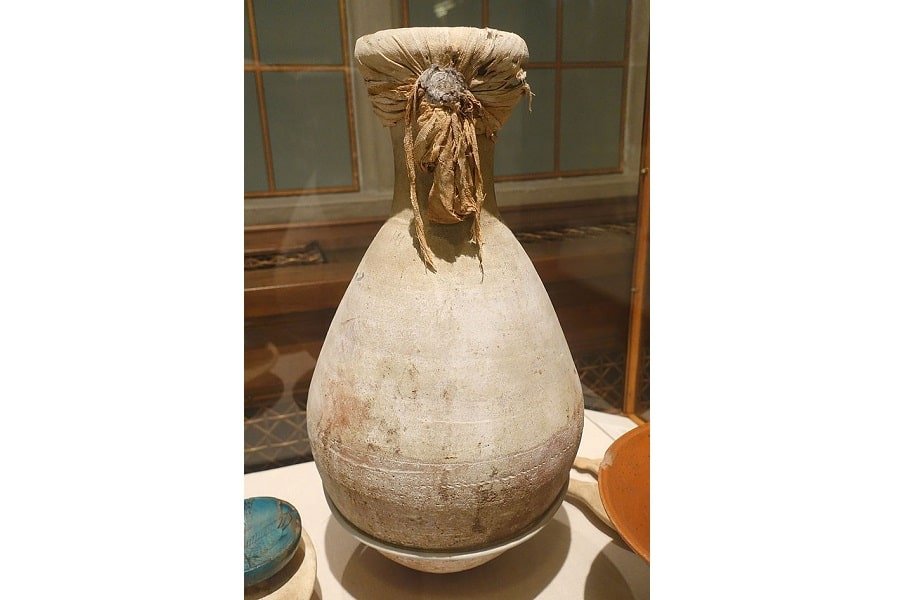
A massive part of Egyptian history is stored on the walls of tombs and temples. The dead give us just as much information about Egyptian life and culture as the living do. Thus, it is no surprise that we would come across paintings of the Royal Bakery in the tomb of Ramses III in the Valley of the Kings. This painting actually depicts the entire process of bread making in ancient Egypt and gives us the information that the Egyptians liked to make bread in interesting shapes.
The Metropolitan Museum of Art houses a miniature model of a slaughterhouse retrieved from a tomb in Thebes. This tells us a great deal about how the ancient Egyptians prepared their cattle for the ritual sacrifices. Painted scenes on tombs provide details about the rearing of ducks and geese, the hunting of fowl, and the working of dairy farms.
The ancient Egyptians believed that just like the living, the dead also needed sustenance. They had to make provisions for the afterlife. The basic part of these provisions was placing food in the tombs so that the dead could have food during their journey to the afterlife. Victuals were placed in the tomb itself beside the mummy.
The gods too required sustenance. This is why the temples had people cooking for them. The priests recognized that the giving of food to the gods was only symbolic in nature and would thus redistribute the food among the poor after a while.
What Can King Tutankhamun Tell Us?
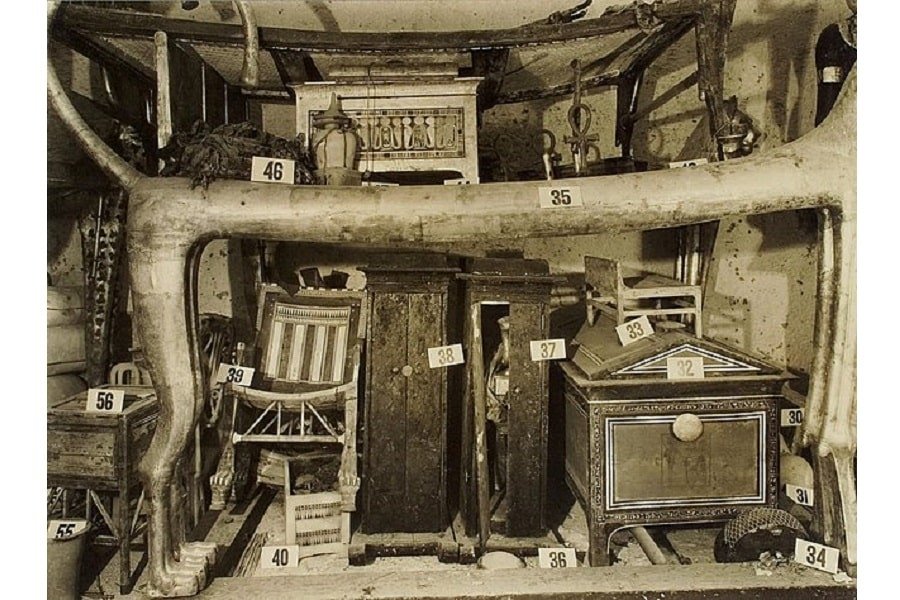
So what can King Tut’s Tomb, the best-preserved tomb, tell us? Archaeological evidence uncovered a copious feast in the tomb. Apart from the staple foods of ancient Egypt, various exotic foods were also discovered. This showed that Egypt traded with other kingdoms in the ancient Middle East and Mediterranean.
The food items uncovered in the tomb are emmer wheat, chickpeas, garlic, cumin, lentils, fenugreek, coriander seeds, watermelon, figs, dates, palm fruits, juniper berries, pomegranates, Christ thorn, and almonds. The almonds were almost certainly a foreign import.
Agriculture, Fishing, and Fowling in Ancient Egypt
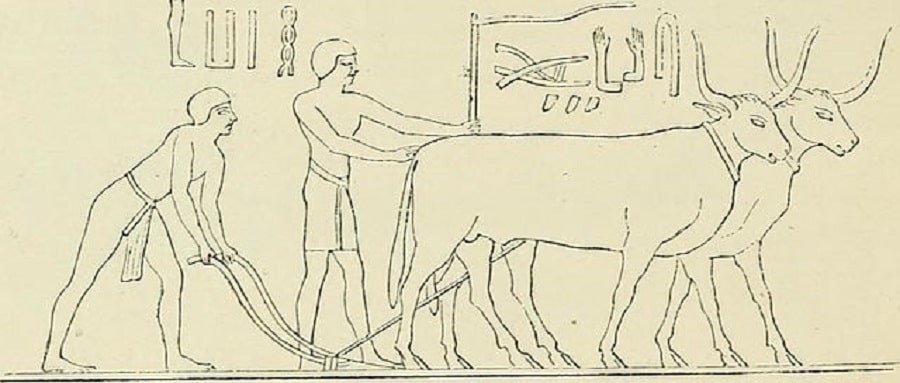
Agriculture was an extremely important part of the lifestyle in ancient Egypt. Situated beside the Nile River which regularly flooded its banks, the ancient Egyptians had access to very fertile soil. This enabled them to grow barley, wheat, vegetables, and fruits.
Tombs in the Deir el-Medina from the early Ramesside period have paintings depicting an Egyptian couple harvesting crops. This seems to indicate that both male and female workers were involved in farming.
The Egyptians are credited as being among the first people in the world to practice agriculture on a large scale. They had sophisticated irrigation systems and plows pulled by cattle. They are also one of the first civilizations to domesticate donkeys.
The Influence of the River Nile
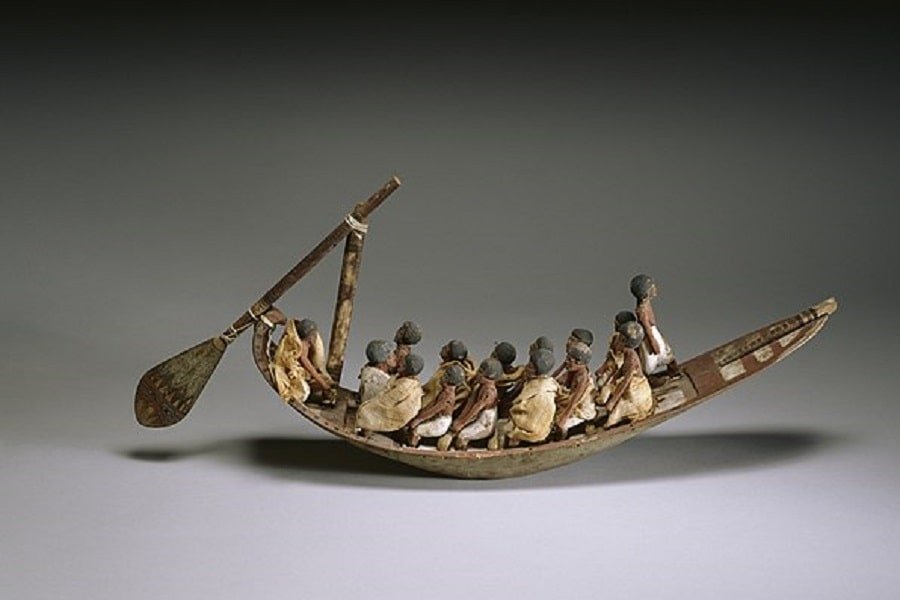
Most ancient civilizations grow along the banks of large water bodies. Ancient Egypt was situated between the Mediterranean and Red Seas and grew along the banks of the River Nile. This was extremely important because the waters were the source of food.
READ MORE: Who Invented Water? History of the Water Molecule
The Egyptians set up an extremely advanced irrigation system by digging a series of canals around the Nile. This ensured water throughout the year and they were able to complete several harvests annually. The Egyptians practiced crop rotation and grew legumes between grain harvests to replenish the soil. Their knowledge of the seasons and the movements of the celestial bodies helped them in their agricultural pursuits.
Apart from agriculture, the Nile also provided fish. Although fishing was a risky business in Egypt, because of the presence of creatures like crocodiles and the hippopotamus, it was still one of the primary businesses among the ancient Egyptians. It is clear that the values outweighed the risks.
Egypt was also home to marshlands and swamps. These wetlands in the Nile Delta attracted a large number of migrating Eurasian birds. Thus, fowling was a major occupation among the Egyptian people. Fowl were hunted both as food and as offerings to the dead and the gods. It was also a sport among the royalty and the elite. This is why even the common people could afford poultry in those days.
Storage and Preservation of Food
Preservation of food is essential in any culture. You do not produce only as much food as you eat at the moment. You also have to store it for later, leaner seasons when nothing might be available. The ancient Egyptians stored their grains and cereals and also preserved their meats in case of droughts or famines.
READ MORE: Who Invented Cereal? History of the Popular Breakfast
Ancient Egyptian storage methods included drying and salting meat and fish and preserving beer and wine in glazed pots. Fruits like grapes, figs, and dates were dried for long-term storage. And the people of ancient Egypt always kept various spices and herbs at hand for flavoring.
Large granaries with sealed jars have been found in archaeological excavations. These were meant to store excess harvests for future purposes. The ancient Egyptians knew how to pickle and can their vegetables and proteins.
Having access to the river meant that they had a pretty consistent source of water. Still, they liked to be prepared for any situation. The Nile, unlike the Tigris and the Euphrates rivers along which the Mesopotamian civilization had grown, was flooding pretty regularly. But there were years when it did not flood its banks and this could lead to droughts.